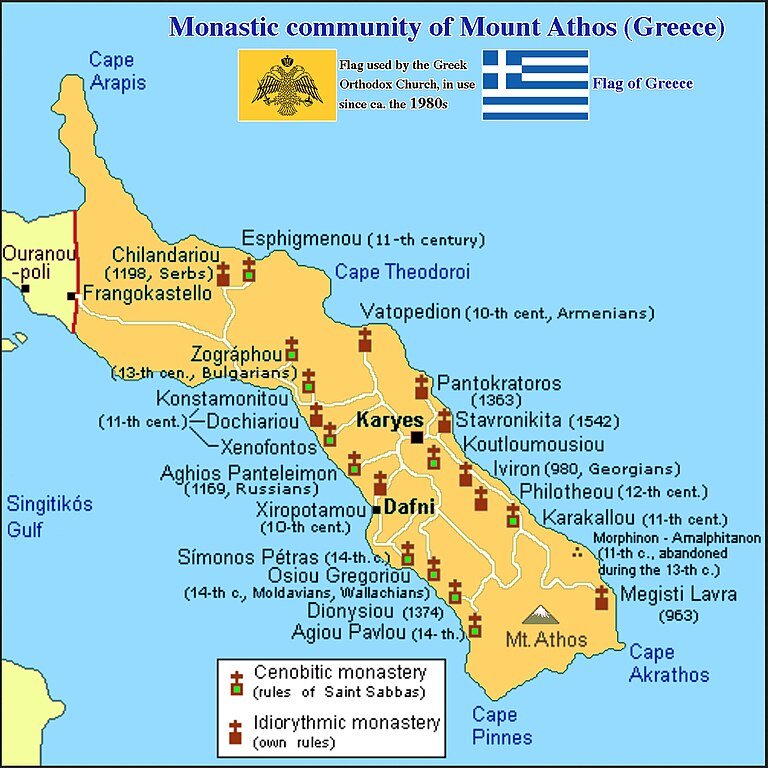SAINTS OF UKRAINE: St. Anthony of the Kyivan Caves
As excerpted from Wikipedia.Anthony of Kyiv also called Anthony of the Caves (Ukrainian: Антоній Печерський), c. 983–1073, was a monk and the founder of the monastic tradition in Kyivan Rus'. Together with Theodosius of Kyiv, he co-founded the Kyiv Pechersk Lavra (Kyiv Monastery of the Caves).
Early Life
He was born in Liubech (present-day Ukraine) in the Chernihiv Principality and was baptized with the name "Antipas". He was drawn to the spiritual life from an early age and left for the Greek Orthodox Esphigmenou Monastery on Mount Athos to live as a hermit. He lived in a secluded cave there overlooking the sea, which is open to visitors today. In circa 1011, the abbot gave Anthony the job of expanding monasticism in his native Kyiv, which had only recently begun its conversion to Christianity.
Return to Kyiv
Anthony returned to Kyiv, and found several monasteries established on the order of local princes, but these were not as austere as Anthony was used to from his time on Mount Athos. He instead chose to live in a small cave which had been dug by the presbyter Hilarion.
In 1015, his peaceful austerity was interrupted by the death of Volodymyr the Great, and the subsequent fratricidal war for the throne between Volodymyr's sons Yaroslav and Sviatopolk, and Anthony returned to Mount Athos. When the conflict ended, the abbot sent Anthony back to Kyiv, prophesying that many monks would join him on his return.
Establishment of Kyiv Pechersk Lavra
Anthony became well known in the area for his strict asceticism. He ate rye bread every other day and drank only a little water. His fame soon spread beyond Kyiv, and several people began to ask for his spiritual guidance or blessing. Soon, some people even offered to join him. Eventually, Anthony accepted the company of a few of them. The first was a priest named Nikon. The second was Theodosius of Kyiv.
The new monastery enjoyed royal favor almost from the beginning, although there were occasional problems. When Iziaslav I of Kyiv demanded that the son of a wealthy boyar and one of his own retainers be told to leave the monastery, Nikon said he could not take soldiers away from the King of Heaven. This did nothing to placate Iziaslav's anger, and Anthony decided that it might be expedient for him to leave. Anthony returned after Iziaslav's wife requested his return.
Shortly thereafter Anthony had gained twelve disciples. They dug a large cave and built a church and cells for the monks within it, thus laying the foundation of what was to become the renowned Kyiv Caves Lavra. Anthony appointed Barlaam of Kyiv as the first abbot. Devoted to the model of the solitary hermit set by his namesake Anthony the Great, Anthony then left his cave for a nearby mountain so he could continue to live the solitary life. There he dug another cave for himself and lived in seclusion there. This cave became the first of what would later be known as the Far Caves.
In time, Barlaam, was called by Iziaslav to head a new monastery, St. Demetrios, which had been built at the gates of the city. The monks requested Anthony to name a replacement, and he named Theodosius.
As the number of monks grew and crowding became a problem, Anthony requested that Iziaslav give them the hill in which the caves were located. He did so, and the monks built a wooden church in honour of the Dormition of the Theotokos, and some cells there, encircling the area with a wooden fence. Theodosius continued to consult Anthony in the guidance of the community and, as the monastery grew, so did Anthony's reputation.
Exile and Return
When Iziaslav and his brothers were facing a popular uprising involving the Cumans, they came to Anthony for his blessing. They did not get it. Anthony foretold that because of their sins they would be defeated, and that the brothers would be buried in a church they would build. Shortly thereafter Iziaslav left because of the rebellion. He suspected Anthony of sympathizing with the opposition and arranged to banish Anthony upon his return. Before he could do so, Iziaslav's brother, Sviatoslav, arranged for Anthony to be secretly taken to Chernihiv. Anthony dug himself a cave there. The Eletsky Monastery there is said by some to be built on the site of Anthony's cave. Eventually Iziaslav was again reconciled to Anthony and asked that he return to Kyiv.
On his return, Anthony and Theodosius decided to build a larger stone church to accommodate the ever-increasing number of monks. Anthony himself did not live to see the church completed. He died in 1073 at the age of ninety, shortly after blessing the foundation of the new church. Shortly before his death he called the monks together and consoled them about his coming death. He also asked them that his remains be hidden away forever. The monks carried out his request. He was reportedly buried in his cave, but no relics have ever been found. Many however have subsequently come to the cave to pray and many of them have reported being healed there.
Veneration
St. Anthony is venerated as a saint and the founder of monasticism in Kyivan Rus'. His feast day falls on July 23 [old calendar]. Saint Anthony is also venerated by Greek Catholics and is listed in the Martyrologium Romanum of the Roman Catholic Church with a feast day of 7 May.
His relics have never been found.




